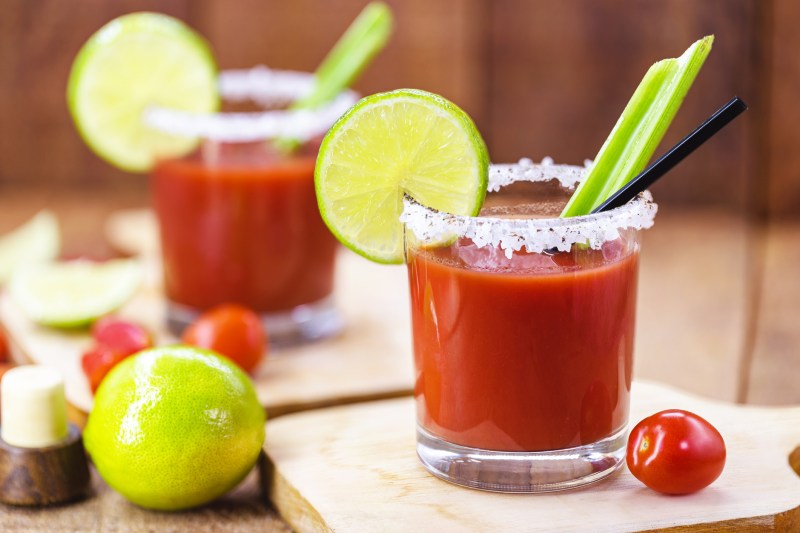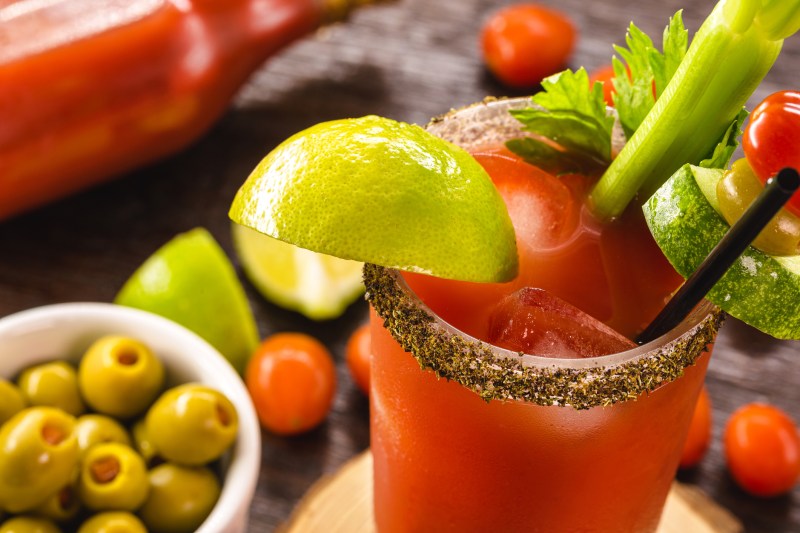Canadians are generally reluctant to pat themselves on the back, but at certain things — hockey, poutine, and recreational cannabis for instance — the Great White North simply does it better than the U.S. The same applies to a certain well-known tomato-based brunch cocktail. We’re talking about the much-loved Caesar, aka the Bloody Caesar. Like its American cousin that goes by the name of Mary, the Caesar has tomato juice, vodka, and a variable level of spiciness. Yet it also contains clam juice, which surprisingly adds a whole new level of depth to the drink, elevating it from mere ‘hair of the dog’ after a night of heavy drinking to a savory classic you can enjoy just about any time.
Related Guides
Bloody Caesar

Ingredients:
- 2 oz vodka
- 1/2 teaspoon of celery salt
- 1/2 teaspoon of garlic salt
- juice from half a lime
- 4 oz Clamato or any other tomato-clam juice mix
- 2 dashes Worcestershire sauce
- 2 dashes Tabasco (or other hot sauce)
- 1 tbsp horseradish (optional)
- celery stalk for garnish
- other optional garnishes: pickled green bean, lime wedge, olives, bacon strip, freshly shucked oyster
Method:
- Mix together the celery salt and garlic salt.
- Coat the rim of a pint glass in lime juice, then dip the glass in the salt mixture to create a spiced rim.
- Fill the glass with ice and set it aside.
- In a separate mixing glass, add the Clamato, vodka, Worcestershire sauce, hot sauce, and optional horseradish.
- Stir briefly, then pour the mixture into prepared glass.
- Garnish with celery and any other optional additions.
Elixir of Love

Some Canadians claim the Bloody Caesar is an aphrodisiac, and that its love-potion properties are powered by clam juice and other “secret ingredients.” Perhaps this explains why the briny beverage is widely considered Canada’s favorite cocktail, with well over 400 million quaffed each year (enough for every man, woman, and child in the country to have a dozen each). When mixing one up, most Canadians reach for a bottle of prepared mix known as Clamato — a portmanteau of “clam” and “tomato” — which contains not only tomato (concentrate) and clam (dried clam broth, actually), but also a fair amount of sugar (in the form of high fructose corn syrup) and lots of salt, as well as MSG. It also contains the requisite spices, onion and garlic powder, and red chili pepper.
If you want to avoid some of the less desirable elements of Clamato, you can make your own Caesar base, using a four-to-one ratio of tomato to clam juice (Bar Harbor produces an excellent all-natural version). Add to this hot sauce, lemon juice, celery salt, garlic, and onion powder, and black pepper, and you’ve got a much improved homemade version of the tangy drink.
Hail, Caesar
The Caesar was born in 1969 when bartender Walter Chell was asked to create a signature drink to celebrate the opening of an Italian restaurant in Calgary. At least, this is how the official story goes. But like all accounts of cocktail creations, the record is a little murkier when you zoom in for a closer look. McCormick, an American company, was selling pre-made clamato juice as early as 1961, and in 1968 a U.S. marketing team unveiled the Clamdigger, which was basically a Caesar without the spices. Yet, this clammy concoction was basically a ripoff of yet another little-known cocktail called the Smirnoff Smiler that debuted at a Polish nightclub in New York City in 1958.
Regardless of who was the first to dream up the unusual combination, the Caesar remains beloved by Canadians of every province and political persuasion. There’s even a National Caesar Day, held on the Thursday before Victoria Day in May. What’s Victoria Day? A celebration in honor of Queen Victoria, naturally — except in Québec, where they don’t have much use for old English nostalgia, and instead fête the Journée Nationale des Patriotes in honor of those brave Québécois who struggled against their British oppressors. But perhaps more than anything, it’s a reminder that Canada is a lot more complicated than just being our overly nice Americanized neighbors to the north.



